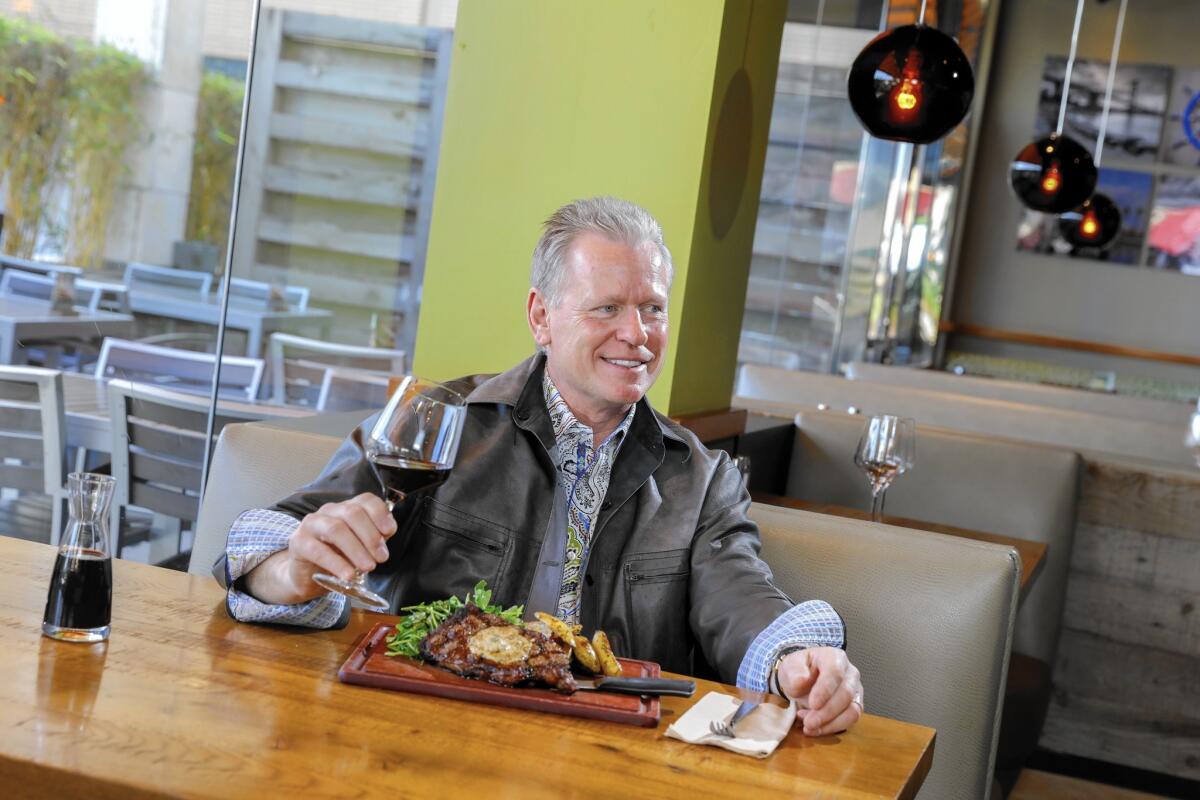How I Made It: He’s joined the upper crust at California Pizza Kitchen

- Share via
The gig: G.J. Hart (the initials stand for Gerard Johan) heads California Pizza Kitchen, the restaurant chain based in Playa Vista. As chief executive and executive chairman, Hart, 58, oversees a company with nearly 300 eateries and 14,000 employees around the world. Hart has been in charge of turning around the fast-casual chain, which suffered years of sales declines before it was taken private in 2011. He has led efforts to revamp both the menus and the look of the eateries to keep up with the changing palates of America’s diners.
The Dutch boy: Hart was born in the Netherlands and immigrated with his parents and sister to the U.S. at age 5. Growing up in modest circumstances, Hart said he knew he’d have to make his own way in the world. He got his first job as a Little League umpire at age 13. Hart also worked as a Kmart cashier, a highway flagman and a Howard Johnson’s dishwasher and short-order cook. “I’ve always wanted to get ahead,” Hart said.
Turkey calling: Because he had to put himself through college, it took nearly nine years for Hart to earn a business management degree from James Madison University in Virginia. During that time, he worked at a poultry company, starting as a trainee hanging turkeys and eventually working up to general manager. The president was “tough as nails” but nurtured and gave Hart a management job in his early 20s. The mentor championed Hart when the business restructured; as a result, he got a minority stake at age 25. “What I did learn, besides leadership, is that I love the food business.”
Emergency man: Hart said much of his success can be attributed to being perpetually available — a “911 person,” as he calls it. “Are you always there?” he said. “Or do you let the phone ring and not call people back?” Capitalizing on opportunities was crucial. Hart said he snatched a chance in his late 20s to become president of the U.S. arm of a New Zealand food import company. Despite his youth, the board gave Hart the job because they thought Dutch people “had integrity and were good businesspeople,” he said. “In my mind, it’s always this mentality — seize the opportunity, because you don’t when it’s going to come, and you need to be ready.”
Texas BBQ: In the late 1990s, Hart met Kent Taylor, the founder of the barbecue chain Texas Roadhouse, at a conference in Napa Valley. Hart was living in New Orleans working for Copeland Investments, founded by Al Copeland, the man behind Popeye’s Famous Fried Chicken. Back then, Texas Roadhouse operated only a handful of restaurants. The founder recruited him aggressively; in return for a large pay cut, Hart would get the chance to invest in restaurants as the chain grew. “I would take a huge step back financially to bet on the future of something cool and very different,” he said. The concept — targeting smaller towns in Middle America, and requiring buy-in from managers — was worth the risk, Hart said. The chain went public in 2004. Hart not only had a “very good stake” in the business, but he also became CEO.
California dreaming: Then Golden Gate Capital, the private equity firm that acquired California Pizza Kitchen in 2011, came calling. Hart said he had envisioned staying at Texas Roadhouse forever. He and Taylor had built the barbecue chain as a team, but Hart wanted to see if he could succeed solo. “I had to see if I was any good,” Hart said. Plus, the private equity firm gave him a chance to invest in the chain when he joined in 2011. Hart said he has “a substantial stake” in California Pizza Kitchen but declined to be specific.
Town halls: The pizza and pasta chain was battered by the rise of fast-casual rivals like Chipotle and a rigid top-down approach, Hart said. He traveled the country holding town-hall-style meetings with about 5,000 employees, asking for their input. It took a long time before workers started believing that his collaborative management style was real, Hart said. At his first meeting with senior team members, Hart said he asked one executive his opinion on a question. “He literally looked behind him, like, ‘Who’s he talking to?’” Hart recalled. “Once you put someone in a box, they are going to stay in the box unless you open them.”
Swallowing change: In just a few years, Hart has made many changes. Servers man fewer tables to improve customer service. Employees are hired for attitude, not experience. And even longtime employees, like managers and tenured cooks, are required to work nights and weekends. The menu has been slimmed down and incorporates dishes with more local ingredients. Many of these changes were initially hard for employees to swallow, Hart said. “I got an earful in some cases,” he said. “But I was willing to listen. That’s the key: consistency, genuineness and being open and willing to listen.”
Off the clock: In his spare time, Hart likes being active, including biking and boating. “Anything outdoors,” he said.
Family: Hart and his wife, Heather, have four children. Hart has a 32-year-old daughter, Ashley, from a previous marriage; he also adopted Heather’s three kids from her first marriage: Hillary, 25; Ashley, 23; and Randall, 14. Both Ashleys have the same middle initial – S. – and the last name of Hart. Flying as a family often involves a conversation with Transportation Security Administration officials. “The TSA really doesn’t know what to do,” Hart said. “They think we’re nuts.”
Twitter: @ByShanLi
More to Read
Inside the business of entertainment
The Wide Shot brings you news, analysis and insights on everything from streaming wars to production — and what it all means for the future.
You may occasionally receive promotional content from the Los Angeles Times.









